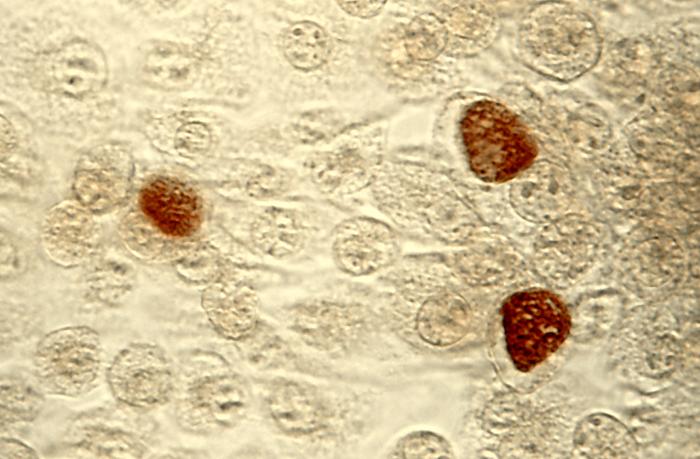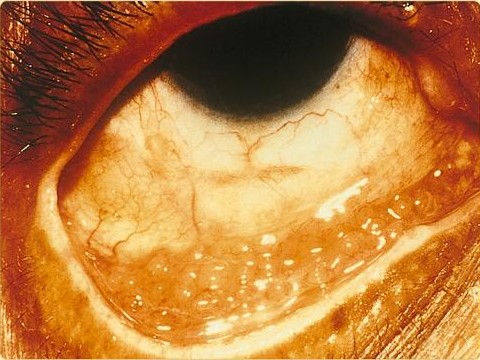Chlamydia trachomatis: Difference between revisions
YazanDaaboul (talk | contribs) |
YazanDaaboul (talk | contribs) |
||
| Line 22: | Line 22: | ||
{{CMG}} | {{CMG}} | ||
==Overview== | ==Overview== | ||
'''''Chlamydia trachomatis''''', an [[Obligate intracellular parasite|obligate intracellular]] [[human pathogen]], is one of four [[bacteria]]l species in the [[genus]] ''[[Chlamydia (genus)|Chlamydia]]''.<ref name=Sherris>{{cite book | author = Ryan KJ, Ray CG (editors) | title = Sherris Medical Microbiology | edition = 4th | pages=463–70| publisher = McGraw Hill | year = 2004 | isbn = 0-8385-8529-9}}</ref> ''C. trachomatis'' is a [[Gram-negative bacteria| | *'''''Chlamydia trachomatis''''', an [[Obligate intracellular parasite|obligate intracellular]] [[human pathogen]], is one of four [[bacteria]]l species in the [[genus]] ''[[Chlamydia (genus)|Chlamydia]]''.<ref name=Sherris>{{cite book | author = Ryan KJ, Ray CG (editors) | title = Sherris Medical Microbiology | edition = 4th | pages=463–70| publisher = McGraw Hill | year = 2004 | isbn = 0-8385-8529-9}}</ref> | ||
*''C. trachomatis'' is a [[Gram-negative bacteria|Gram-negative]] bacterium, therefore its cell wall components retain the counter-stain [[safranin]] and appear pink under a light microscope.<ref name=MW>{{cite web |url=http://microbewiki.kenyon.edu/index.php/Chlamydia |title=Chlamydia |publisher=Department of Biology, Kenyon College |work=MicrobeWiki | date=2006-08-15 | accessdate=2008-10-27}}</ref> It is ovoid in shape.<ref>{{cite journal |vauthors=Malhotra M, Sood S, Mukherjee A, Muralidhar S, Bala M |title=Genital Chlamydia trachomatis: an update |journal=Indian J. Med. Res. |volume=138 |issue=3 |date= September 2013|pages=303–16|pmid=24135174 |pmc=3818592 |doi= |url=}}</ref><!--review article --> | |||
''C. trachomatis'' includes three human [[biovar]]s: | ''C. trachomatis'' includes three human [[biovar]]s: | ||
| Line 30: | Line 30: | ||
*serovars L1, L2 and L3 — [[lymphogranuloma venereum]] (LGV).<ref>{{cite journal |author=Fredlund H, Falk L, Jurstrand M, Unemo M |title=Molecular genetic methods for diagnosis and characterisation of ''Chlamydia trachomatis'' and ''Neisseria gonorrhoeae'': impact on epidemiological surveillance and interventions |journal=APMIS : acta pathologica, microbiologica, et immunologica Scandinavica |volume=112 |issue=11–12 |pages=771–84 |year=2004 |pmid=15638837 |doi=10.1111/j.1600-0463.2004.apm11211-1205.x |url=http://www.blackwell-synergy.com/openurl?genre=article&sid=nlm:pubmed&issn=0903-4641&date=2004&volume=112&issue=11-12&spage=771}}</ref> | *serovars L1, L2 and L3 — [[lymphogranuloma venereum]] (LGV).<ref>{{cite journal |author=Fredlund H, Falk L, Jurstrand M, Unemo M |title=Molecular genetic methods for diagnosis and characterisation of ''Chlamydia trachomatis'' and ''Neisseria gonorrhoeae'': impact on epidemiological surveillance and interventions |journal=APMIS : acta pathologica, microbiologica, et immunologica Scandinavica |volume=112 |issue=11–12 |pages=771–84 |year=2004 |pmid=15638837 |doi=10.1111/j.1600-0463.2004.apm11211-1205.x |url=http://www.blackwell-synergy.com/openurl?genre=article&sid=nlm:pubmed&issn=0903-4641&date=2004&volume=112&issue=11-12&spage=771}}</ref> | ||
Many, but not all, ''C. trachomatis'' strains have an extrachromosomal [[plasmid]].<ref>{{cite journal |author=Carlson JH, Whitmire WM, Crane DD |title=The ''Chlamydia trachomatis'' Plasmid Is a Transcriptional Regulator of Chromosomal Genes and a Virulence Factor |journal=Infection and immunity |volume=76 |issue=6 |pages=2273–83 |date=June 2008 |pmid=18347045 |pmc=2423098 |doi=10.1128/IAI.00102-08 |url=http://iai.asm.org/cgi/pmidlookup?view=long&pmid=18347045|display-authors=etal}}</ref> | *Many, but not all, ''C. trachomatis'' strains have an extrachromosomal [[plasmid]].<ref>{{cite journal |author=Carlson JH, Whitmire WM, Crane DD |title=The ''Chlamydia trachomatis'' Plasmid Is a Transcriptional Regulator of Chromosomal Genes and a Virulence Factor |journal=Infection and immunity |volume=76 |issue=6 |pages=2273–83 |date=June 2008 |pmid=18347045 |pmc=2423098 |doi=10.1128/IAI.00102-08 |url=http://iai.asm.org/cgi/pmidlookup?view=long&pmid=18347045|display-authors=etal}}</ref> | ||
Chlamydia can exchange DNA between its different strains, thus the evolution of new strains is common.<ref>{{cite journal |author=Harris SR, Clarke IN, Seth-Smith HM |title=Whole-genome analysis of diverse ''Chlamydia trachomatis'' strains identifies phylogenetic relationships masked by current clinical typing |journal=Nat. Genet. |volume=44 |issue=4 |pages=413–9, S1 |date=April 2012 |pmid=22406642 |pmc=3378690 |doi=10.1038/ng.2214 |display-authors=etal}}</ref> | *Chlamydia can exchange DNA between its different strains, thus the evolution of new strains is common.<ref>{{cite journal |author=Harris SR, Clarke IN, Seth-Smith HM |title=Whole-genome analysis of diverse ''Chlamydia trachomatis'' strains identifies phylogenetic relationships masked by current clinical typing |journal=Nat. Genet. |volume=44 |issue=4 |pages=413–9, S1 |date=April 2012 |pmid=22406642 |pmc=3378690 |doi=10.1038/ng.2214 |display-authors=etal}}</ref> | ||
==Identification== | ==Identification== | ||
Revision as of 17:01, 5 February 2016
|
Chlamydia infection Microchapters |
|
Diagnosis |
|
Treatment |
|
Case Studies |
|
Chlamydia trachomatis On the Web |
|
American Roentgen Ray Society Images of Chlamydia trachomatis |
| Chlamydia trachomatis | ||||||||||
|---|---|---|---|---|---|---|---|---|---|---|
 C. trachomatis inclusion bodies (brown) in a McCoy cell culture.
| ||||||||||
| Scientific classification | ||||||||||
| ||||||||||
| Species | ||||||||||
|
Chlamydia muridarum
Chlamydophila pneumoniae |
Editor-In-Chief: C. Michael Gibson, M.S., M.D. [1]
Overview
- Chlamydia trachomatis, an obligate intracellular human pathogen, is one of four bacterial species in the genus Chlamydia.[1]
- C. trachomatis is a Gram-negative bacterium, therefore its cell wall components retain the counter-stain safranin and appear pink under a light microscope.[2] It is ovoid in shape.[3]
C. trachomatis includes three human biovars:
- serovars Ab, B, Ba, or C — cause trachoma: infection of the eyes, which can lead to blindness
- serovars D-K — cause urethritis, pelvic inflammatory disease, ectopic pregnancy, neonatal pneumonia, and neonatal conjunctivitis
- serovars L1, L2 and L3 — lymphogranuloma venereum (LGV).[4]
- Chlamydia can exchange DNA between its different strains, thus the evolution of new strains is common.[6]
Identification
Chlamydia species are readily identified and distinguished from other Chlamydia species using DNA-based tests.
Most strains of C. trachomatis are recognized by monoclonal antibodies (mAbs) to epitopes in the VS4 region of MOMP.[7] However, these mAbs may also cross-react with two other Chlamydia species, C. suis and C. muridarum.
Life-cycle
Chlamydiae are obligate intracellular bacterial pathogens, which means they are unable to replicate outside of a host cell. However, to disseminate effectively, these pathogens have evolved from a unique biphasic life cycle wherein they alternate between two functionally and morphologically distinct forms.
- The elementary body (EB) is infectious, but metabolically inert (much like a spore), and can survive for limited amounts of time in the extracellular milieu. Once the EB attaches to a susceptible host cell, it mediates its own internalization through pathogen-specified mechanisms (via type III secretion system) that allows for the recruitment of actin with subsequent engulfment of the bacterium.
- The internalized EB, within a membrane-bound compartment, immediately begins differentiation into the reticulate body (RB). RBs are metabolically active but non-infectious, and in many regards, resemble normal replicating bacteria. The intracellular bacteria rapidly modifies its membrane-bound compartment into the so-called chlamydial inclusion so as to prevent phagosome-lysosome fusion. The inclusion is thought to have no interactions with the endocytic pathway and apparently inserts itself into the exocytic pathway as it retains the ability to intercept sphingomyelin-containing vesicles.
- The mechanism by which the host cell protein is trafficked to the inclusion through the exocytic pathway is not fully understood. As the RBs replicate, the inclusion grows as well to accommodate the increasing numbers of organisms. Through unknown mechanisms, RBs begin a differentiation program back to the infectious EBs, which are released from the host cell to initiate a new round of infection. Because of their obligate intracellular nature, Chlamydiae have no tractable genetic system, unlike E. coli, which makes Chlamydiae and related organisms difficult to investigate.
Diseases caused by Chlamydia Trachomatis

Chlamydia trachomatis can cause the following conditions:
- Cervicitis
- Conjunctivitis
- Fitz-Hugh-Curtis syndrome
- Lymphogranuloma venereum
- Pelvic inflammatory disease
- Pneumonia in infants
- Reactive arthritis
- Urethritis
- Rectal infection (proctitis)
- Prostatitis
- Ectopic pregnancy
Gallery
-
Photomicrograph of Chlamydia trachomatis taken from a urethral scrape. From Public Health Image Library (PHIL). [8]
-
McCoy cell monolayers with Chlamydia trachomatis inclusion bodies (200X mag). From Public Health Image Library (PHIL). [8]
-
McCoy cell monolayers with Chlamydia trachomatis inclusion bodies (50X mag). From Public Health Image Library (PHIL). [8]
-
Photomicrograph depicts HeLa cells infected with Type-A Chlamydia trachomatis (400X mag). From Public Health Image Library (PHIL). [8]
-
Patient’s left eye with the upper lid retracted in order to reveal the inflamed conjunctival membrane lining the inside of both the upper and lower lids, due to what was determined to be a case of inclusion conjunctivitis caused by the bacterium, Chlamydia trachomatis. From Public Health Image Library (PHIL). [8]
References
- ↑ Ryan KJ, Ray CG (editors) (2004). Sherris Medical Microbiology (4th ed.). McGraw Hill. pp. 463–70. ISBN 0-8385-8529-9.
- ↑ "Chlamydia". MicrobeWiki. Department of Biology, Kenyon College. 2006-08-15. Retrieved 2008-10-27.
- ↑ Malhotra M, Sood S, Mukherjee A, Muralidhar S, Bala M (September 2013). "Genital Chlamydia trachomatis: an update". Indian J. Med. Res. 138 (3): 303–16. PMC 3818592. PMID 24135174.
- ↑ Fredlund H, Falk L, Jurstrand M, Unemo M (2004). "Molecular genetic methods for diagnosis and characterisation of Chlamydia trachomatis and Neisseria gonorrhoeae: impact on epidemiological surveillance and interventions". APMIS : acta pathologica, microbiologica, et immunologica Scandinavica. 112 (11–12): 771–84. doi:10.1111/j.1600-0463.2004.apm11211-1205.x. PMID 15638837.
- ↑ Carlson JH, Whitmire WM, Crane DD; et al. (June 2008). "The Chlamydia trachomatis Plasmid Is a Transcriptional Regulator of Chromosomal Genes and a Virulence Factor". Infection and immunity. 76 (6): 2273–83. doi:10.1128/IAI.00102-08. PMC 2423098. PMID 18347045.
- ↑ Harris SR, Clarke IN, Seth-Smith HM; et al. (April 2012). "Whole-genome analysis of diverse Chlamydia trachomatis strains identifies phylogenetic relationships masked by current clinical typing". Nat. Genet. 44 (4): 413–9, S1. doi:10.1038/ng.2214. PMC 3378690. PMID 22406642.
- ↑ Ortiz L, Angevine M, Kim SK, Watkins D, DeMars R (2000). "T-Cell Epitopes in Variable Segments of Chlamydia trachomatis Major Outer Membrane Protein Elicit Serovar-Specific Immune Responses in Infected Humans". Infect. Immun. 68 (3): 1719–23. doi:10.1128/IAI.68.3.1719-1723.2000. PMC 97337. PMID 10678996.
- ↑ 8.0 8.1 8.2 8.3 8.4 8.5 "Public Health Image Library (PHIL)".
Further reading
Bellaminutti, Serena; Seracini, Silva; De Seta, Francesco; Gheit, Tarik; Tommasino, Massimo; Comar, Manola (November 2014). "HPV and Chlamydia trachomatis Co-Detection in Young Asymptomatic Women from High Incidence Area for Cervical Cancer". Journal of Medical Virology. 86 (11): 1920–1925. doi:10.1002/jmv.24041. Retrieved 13 November 2014.
External links
- Chlamydiae.com
- Template:GPnotebook
- "Chlamydia trachomatis". NCBI Taxonomy Browser. 813.
Template:STD/STI Template:Gram-negative non-proteobacterial bacterial diseases[citation needed]
- CS1 maint: Extra text: authors list
- CS1 maint: Multiple names: authors list
- Chlamydiae
- Sexually transmitted diseases and infections
- Bacteria with sequenced genomes
- Infectious causes of cancer
- Infections with a predominantly sexual mode of transmission
- All articles with unsourced statements
- Articles with unsourced statements from August 2015
- Articles with invalid date parameter in template
- Eradicable diseases
- Infectious disease
- Infectious Disease Project
![Photomicrograph of Chlamydia trachomatis taken from a urethral scrape. From Public Health Image Library (PHIL). [8]](/images/2/21/Chlamydia15.jpeg)
![McCoy cell monolayers with Chlamydia trachomatis inclusion bodies (200X mag). From Public Health Image Library (PHIL). [8]](/images/8/88/Chlamydia11.jpeg)
![McCoy cell monolayers with Chlamydia trachomatis inclusion bodies (50X mag). From Public Health Image Library (PHIL). [8]](/images/e/e2/Chlamydia10.jpeg)
![Photomicrograph depicts HeLa cells infected with Type-A Chlamydia trachomatis (400X mag). From Public Health Image Library (PHIL). [8]](/images/2/29/Chlamydia09.jpeg)
![Patient’s left eye with the upper lid retracted in order to reveal the inflamed conjunctival membrane lining the inside of both the upper and lower lids, due to what was determined to be a case of inclusion conjunctivitis caused by the bacterium, Chlamydia trachomatis. From Public Health Image Library (PHIL). [8]](/images/3/3c/Chlamydia03.jpeg)
![From Public Health Image Library (PHIL). [8]](/images/0/01/Chlamydia04.jpeg)